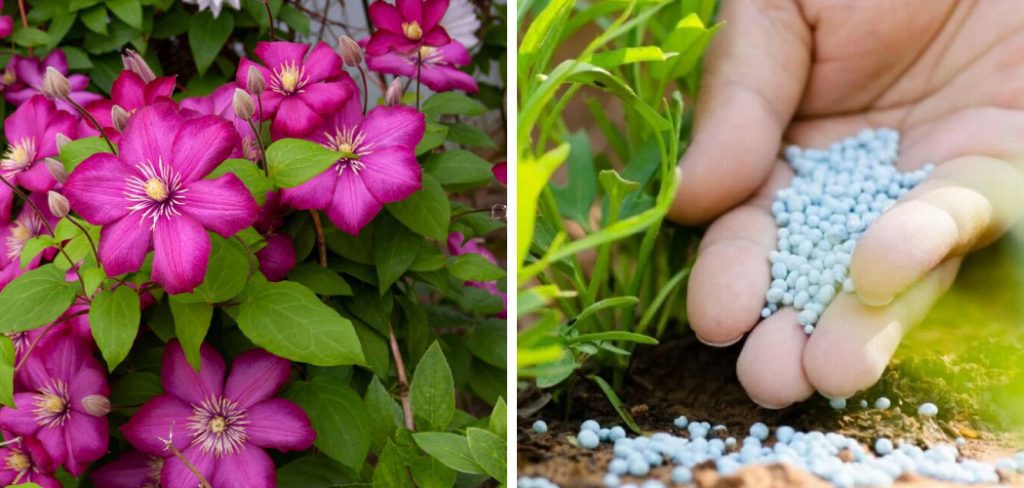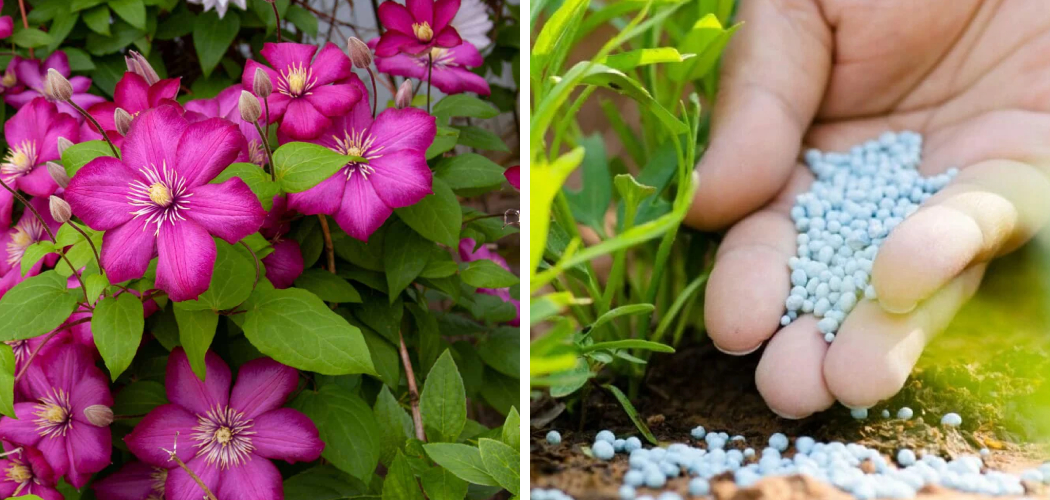To fertilize clematis, apply a slow-release fertilizer in early spring and provide consistent moisture throughout the growing season. Clematis is a beautiful flowering vine that adds vibrant color to any garden.
To ensure healthy growth and abundant blooms, proper fertilization is essential. When it comes to fertilizing clematis, timing is crucial. It is best to apply a slow-release fertilizer in early spring before new growth begins. This will provide a steady supply of nutrients to support the plant throughout the growing season.
Additionally, clematis prefers consistently moist soil, so watering regularly is important. By following these simple guidelines, you can enjoy a thriving clematis with stunning blooms in your garden.

How to Fertilize Clematis: Step by Step Guide
Choosing The Right Fertilizer For Clematis
Choosing the right fertilizer for clematis is crucial for its growth and flowering. Proper fertilization plays a vital role in maintaining the health and vigor of these beautiful flowering plants. When selecting a fertilizer, there are several factors to consider.
First, you need to assess the nutrient needs of your clematis variety. Different types may require specific ratios of nitrogen, phosphorus, and potassium. Next, look for a slow-release fertilizer to provide a steady supply of nutrients over time. This ensures that the clematis receives a balanced and sustained feed.
Additionally, consider the soil ph requirements of your clematis as this can impact nutrient availability. Lastly, follow the application instructions carefully and avoid overfertilization, as it can lead to excessive foliage growth at the expense of blooms. By following these guidelines, you can ensure the proper fertilization of your clematis and enjoy its vibrant and abundant flowers.
Organic Vs. Synthetic Fertilizers
Clematis, a beautiful flowering vine, requires proper fertilization for healthy growth. When considering fertilizers, organic and synthetic options come into play. Organic fertilizers, derived from natural sources, have their advantages and disadvantages. They provide slow-release nutrients, improve soil health, and are environmentally friendly.
On the downside, they may have lower nutrient levels and require larger quantities for effectiveness. Synthetic fertilizers, on the other hand, are readily available and provide instant nutrients. They can be tailored to meet specific plant requirements and offer convenience.
However, they can be harsh on the environment, cause nutrient imbalances, and require careful application. When it comes to clematis, striking the right balance is key. While organic fertilizers support long-term soil health, synthetic fertilizers offer quick results. Ultimately, choosing the better option for clematis depends on individual preferences and gardening practices.
Timing And Frequency Of Fertilization
Fertilizing clematis requires understanding its growth cycles. Knowing when to fertilize is crucial for optimal results. Applying fertilizer too early or too late can negatively impact its growth. It’s important to fertilize clematis during its active growing season. This typically falls between early spring and early fall.
As for frequency, regular fertilization is key. Applying fertilizer every four to six weeks throughout the growing season helps maintain healthy growth. However, it’s essential to avoid over-fertilizing, as this can lead to excessive foliage growth with fewer blooms. Finding the right timing and frequency for fertilizing your clematis will ensure robust and beautiful plants in your garden.
Fertilizer Application Techniques
Fertilizing clematis is an important aspect of maintaining healthy and vibrant plants. Before applying fertilizer, it’s crucial to prepare the soil properly. This involves loosening the soil and removing any weeds or debris. Once the soil is ready, the fertilizer can be applied directly to it.
It’s important to follow the instructions on the fertilizer packaging to ensure the correct amount is used. For maximum nutrient uptake, it’s recommended to place the fertilizer evenly around the base of the plant. This allows the roots to easily access the nutrients.
Regularly fertilizing clematis throughout the growing season will promote strong growth and beautiful blooms. Remember to water the plants after fertilizing to help the nutrients penetrate the soil and reach the root system. By following these techniques, you can ensure your clematis plants thrive and flourish.
Dos And Don’ts Of Fertilizing Clematis
Fertilizing clematis is an important step in ensuring their healthy growth. To achieve successful fertilization, it is crucial to follow a few dos and don’ts. One of the common mistakes to avoid is overfertilizing, as this can lead to excessive growth and weak plants.
Instead, use a balanced nutrient ratio that provides the necessary nutrients without overwhelming the plant. Another tip is to apply fertilizer in early spring, before new growth emerges. This helps to kickstart the plant’s growth for the season. Additionally, it is important to water the plant thoroughly before and after applying fertilizer.
This helps to prevent any potential burning of the roots. By following these guidelines and avoiding common mistakes, you can ensure that your clematis thrives and produces beautiful blooms.
Troubleshooting Fertilizer-Related Issues
Clematis, a beloved flowering plant, requires proper fertilization to thrive. Identifying nutrient deficiencies is crucial in troubleshooting fertilizer-related issues. Nutrient excesses and imbalances must also be addressed to ensure the plant’s health. Adjusting the fertilizer program based on specific needs is key in promoting vibrant growth.
By providing the right nutrients in the right quantities, clematis can flourish and produce stunning blooms. So, whether you’re an avid gardener or just starting out, understanding the importance of fertilizing clematis is essential for successful cultivation. Remember, healthy plants reflect proper care and attention, resulting in a breathtaking display of beauty in your garden.
Alternative Fertilizers For Clematis
Fertilizing clematis is important for healthy growth and abundant blooms. Organic gardeners often prefer natural solutions that are safe for the environment. For those on a budget, homemade fertilizers can be an excellent option. By exploring lesser-known fertilizer options, you can find alternatives that are readily available and affordable.
These alternative fertilizers provide the necessary nutrients for clematis plants to thrive. From compost tea to seaweed extract and bone meal, there are several choices to choose from. Using these natural fertilizers not only benefits your plants but also promotes a sustainable gardening approach.
With the right choice of fertilizer, you can nourish your clematis plants and enjoy beautiful blooms year after year. Improve the health and vitality of your clematis with alternative fertilizers that are cost-effective and environmentally friendly.
Incorporating Fertilization Into A Comprehensive Clematis Care Plan
Fertilizing clematis plants is an important aspect of their overall care routine. It plays a vital role in keeping the plants healthy and promoting their growth. To incorporate fertilization effectively, it is crucial to understand its significance within the broad spectrum of clematis care.
One key step is creating a schedule for fertilizing the plants, ensuring they receive the necessary nutrients at the right time. Additionally, combining fertilization with proper pruning techniques and adequate watering further enhances the health and vitality of the clematis plants.
By incorporating fertilization into a comprehensive care plan, clematis enthusiasts can enjoy vibrant and blooming plants throughout the growing season. Remember to follow these guidelines to provide the best care for your clematis and keep them thriving for years to come.
Best Practices For Long-Term Clematis Fertilization
Assess the overall health of your clematis to determine its fertilization requirements. Regularly monitor and adjust the fertilization process as necessary. By carefully planning, you can ensure long-term fertility. Observing the health and vigor of your clematis helps in gauging its fertilization needs.
Regular fertilization adjustments will keep it thriving. Additionally, it is essential to plan ahead for future fertilization requirements. This will contribute to the continued growth and vitality of your clematis. Maintaining the health and fertility of your clematis is crucial for its long-term well-being.
Remember to be diligent in assessing and adjusting its fertilizer intake to ensure optimal results.
Frequently Asked Questions Of How To Fertilize Clematis
What Is The Best Fertilizer For Clematis?
The best fertilizer for clematis is a balanced, slow-release fertilizer with a ratio of 10-10-10 or 20-20-20. It is important to apply the fertilizer in early spring, just as the plant starts to grow. Apply a layer of compost or well-rotted manure around the base of the plant before applying the fertilizer.
Water the plant well after fertilizing to ensure proper absorption. Avoid over-fertilization, as this can lead to excessive leaf growth and reduce flower production. Regularly check the ph level of the soil, as clematis prefers a slightly acidic to neutral soil ph range of 6.
0-7. 0. Adjusting the ph level can be done by adding lime to raise the ph or sulfur to lower it. Always follow the instructions on the fertilizer packaging and take care not to apply fertilizer directly to the stem or leaves of the plant.
Is Miracle-Gro A Good Fertilizer For Clematis?
Miracle-gro can be a good fertilizer for clematis. It provides essential nutrients like nitrogen, phosphorus, and potassium that help promote healthy growth and vibrant blooms. The balanced formula ensures that the plant receives the right amount of nutrients for optimal health.
It is important to follow the recommended dosage instructions on the packaging and apply the fertilizer evenly around the base of the plant. Regular feeding with miracle-gro can enhance the overall performance of the clematis and improve its ability to withstand stressors such as pests and diseases.
However, it is always a good practice to monitor the plant’s response to the fertilizer and adjust the application rate accordingly. Remember to water the plant adequately after fertilizing to help the nutrients penetrate the soil and reach the roots.
How Do I Get My Clematis To Bloom All Summer?
To ensure your clematis blooms all summer, follow these tips: 1. Plant your clematis in a sunny location with well-drained soil. 2. Provide proper support, such as a trellis or fence, for the vine to climb. 3. Water regularly, keeping the soil moist but not waterlogged.
4. Mulch around the base of the plant to conserve moisture and regulate temperature. 5. Prune annually in late winter or early spring to promote new growth and flowering. 6. Fertilize with a balanced, slow-release fertilizer during the growing season.
7. Remove faded flowers to encourage more blooms. 8. Monitor for pests and diseases, promptly addressing any issues that arise. 9. Consider selecting clematis varieties that are bred to have an extended blooming season. 10. Enjoy the beautiful display of flowers throughout the summer!
Are Coffee Grounds Good For Clematis?
Yes, coffee grounds are good for clematis. The acidity of coffee helps to maintain the ph level of the soil, which is beneficial for clematis plants. Coffee grounds also act as a natural fertilizer, providing essential nutrients like nitrogen, potassium, and phosphorus that promote healthy growth.
To use coffee grounds, simply sprinkle them around the base of the clematis plant, being careful not to pile them too high to prevent excessive acidity. It is recommended to mix the coffee grounds with other organic matter, such as compost, to improve its texture and nutrient content.
Regular application of coffee grounds can enhance the overall health and vigor of clematis plants. Remember, moderation is key when using coffee grounds, as excessive amounts can have adverse effects on the soil.
Conclusion
Properly fertilizing your clematis plants is crucial for their growth and blooming potential. By understanding the different types of fertilizers, the right timing, and the correct application method, you can ensure that your clematis plants receive the nutrients they need to thrive.
Remember to use a balanced fertilizer with a npk ratio suited for flowering plants, apply it in early spring or late winter before new growth appears, and follow the recommended dosage. Additionally, consider organic alternatives like compost or well-rotted manure to provide a gentle and natural approach to feeding your clematis.
Regular monitoring and adjustments based on your plant’s needs will help you achieve beautiful and healthy clematis blooms year after year. So take the time to give your clematis the nourishment it deserves, and enjoy the rewarding results in your garden.

